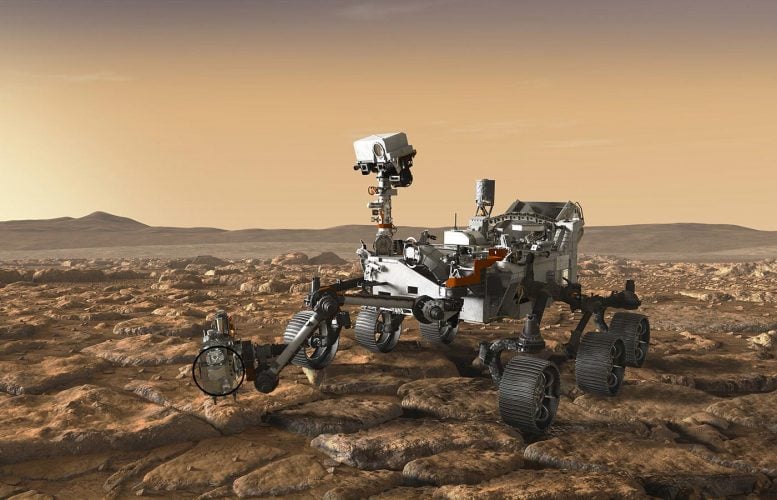
As shown in this artist’s impression, the SHERLOC instrument is located at the end of the robotic arm of NASA’s Perseverance Mars rover. Credit: NASA/JPL-Caltech
After six months of effort, an instrument that helps
” data-gt-translate-attributes=”({“attribute”:”data-cmtooltip”, “format”:”html”})” tabindex=”0″ role=”link”>NASAThe perseverance of
” data-gt-translate-attributes=”({“attribute”:”data-cmtooltip”, “format”:”html”})” tabindex=”0″ role=”link”>Mars The rover searching for potential signs of ancient microbial life is back in operation.
After a mechanical failure interrupted SHERLOC operations on the Perseverance rover, NASA engineers conducted extensive testing and innovative repairs to restore the instrument. Their efforts, which included manipulating rover components to free a stuck lens cover, allowed for continued exploration and data collection on Mars, focusing on geological signs of ancient life.
For the first time since it encountered a problem last January, the SHERLOC (Scanning Habitable Environments with Raman & Luminescence for Organics and Chemicals) instrument aboard NASA’s Perseverance Mars rover has scanned a rocky target with its spectrometer and camera. The instrument plays a key role in searching for signs of ancient microbial life on Mars. Engineers at NASA’s Jet Propulsion Laboratory (JPL) in Southern California confirmed on June 17 that the instrument had successfully collected data.
“Six months of diagnostics, testing, imaging and data analysis, troubleshooting and retesting could not have resulted in a better conclusion,” said Kevin Hand, SHERLOC principal investigator.
” data-gt-translate-attributes=”({“attribute”:”data-cmtooltip”, “format”:”html”})” tabindex=”0″ role=”link”>JPL.
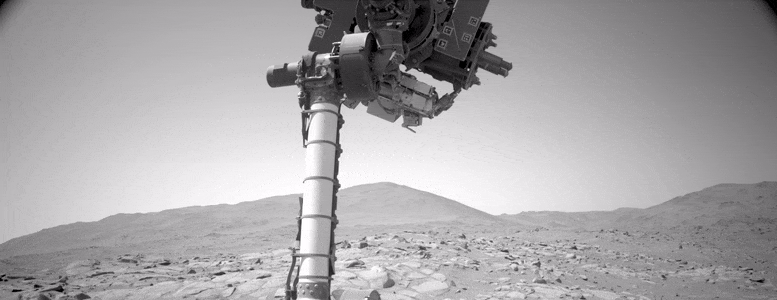
Images taken by a navigation camera aboard NASA’s Perseverance rover on January 23 show the position of a cover on the SHERLOC instrument. The cover had gotten stuck for several weeks before, but the rover team has since found a way to fix the problem so the instrument can continue to operate. Credit: NASA/JPL-Caltech
Mounted on the rover’s robotic arm, SHERLOC uses two cameras and a laser spectrometer to search for organic compounds and minerals in rocks that have been weathered in aqueous environments and that can reveal signs of past microbial life. On Jan. 6, a movable lens cover designed to protect the instrument’s spectrometer and one of its cameras from dust became stuck in a position that prevented SHERLOC from collecting data.
The SHERLOC team’s analysis revealed a malfunction in a small motor that moves the objective lens cover and adjusts the focus of the spectrometer and the Autofocus and Context Imager (ACI) camera. Testing potential solutions on a duplicate SHERLOC instrument at JPL, the team began a lengthy and meticulous evaluation process to see if, and how, the objective lens cover could be moved into the open position.
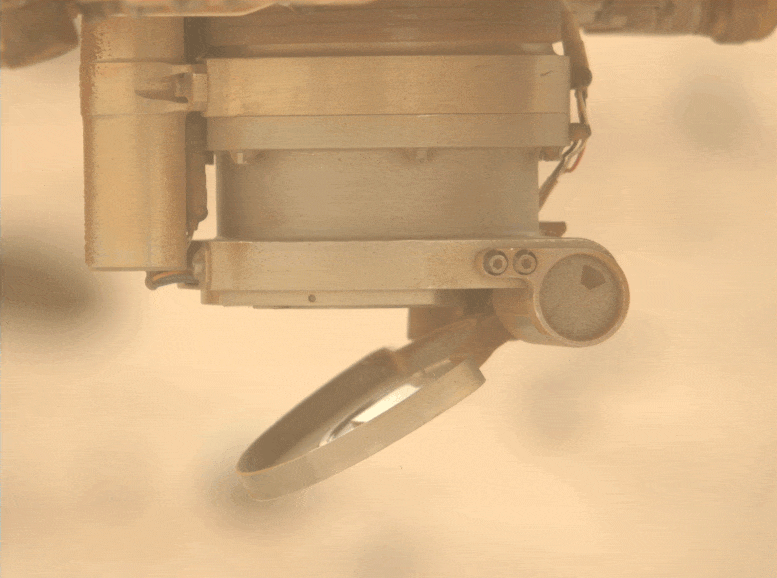
The cover of the Autofocus and Context Imager of SHERLOC, one of the instruments aboard NASA’s Perseverance Mars rover, is seen moving in images captured by the rover’s Mastcam-Z instrument on May 11. Credit: NASA/JPL-Caltech/ASU/MSSS
SHERLOC in investigation
Among many other steps taken, the team tried heating the lens cover’s small motor, commanding the rover’s robotic arm to rotate the SHERLOC instrument in different orientations with Mastcam-Z imaging, rocking the mechanism back and forth to loosen debris that might be blocking the lens cover, and even engaging the rover’s impact drill to try to loosen it. On March 3, images sent back from Perseverance showed that the ACI cover had opened more than 180 degrees, clearing the imager’s field of view and allowing the ACI to be positioned close to its target.
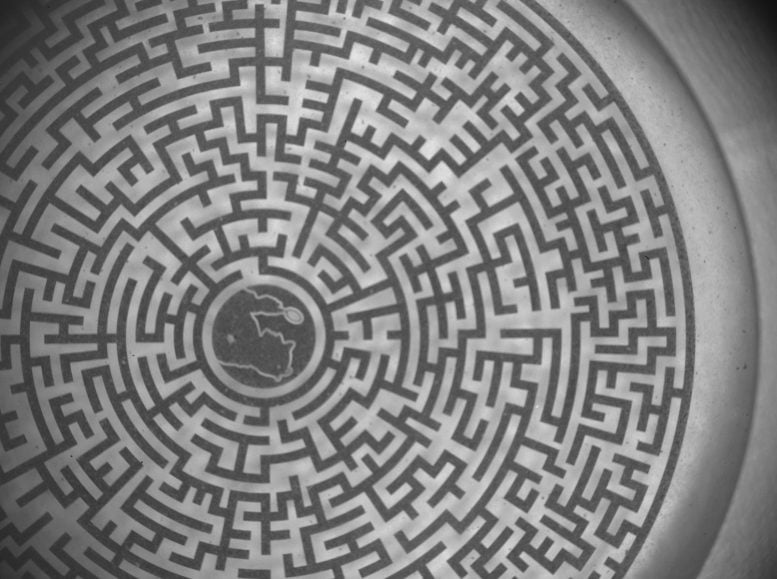
The Perseverance team used the SHERLOC instrument’s autofocus and context imager to capture this image of its calibration target on May 11 to confirm that an issue with a stuck lens cap had been resolved. A silhouette of fictional detective Sherlock Holmes is in the center of the target. Credit: NASA/JPL-Caltech
“Once the cover was removed, a line of sight for the spectrometer and camera was established. We were halfway there,” said Kyle Uckert, SHERLOC deputy principal investigator at JPL. “We still needed a way to focus the instrument on a target. Without a focus, SHERLOC images would be blurry and the spectral signal would be weak.”
Like any good ophthalmologist, the team focused on determining SHERLOC’s prescription. Since they couldn’t adjust the focus of the instrument’s optics, they relied on the rover’s robotic arm to make minute adjustments to the distance between SHERLOC and its target to get the best image resolution. SHERLOC was instructed to take pictures of its calibration target so the team could verify the effectiveness of this approach.
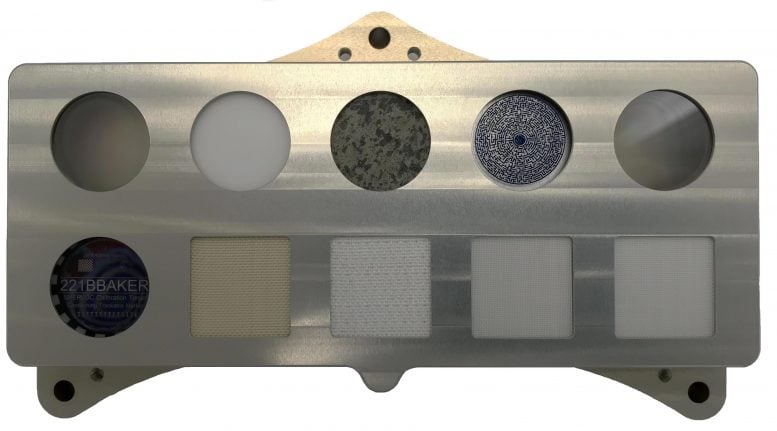
The calibration target for SHERLOC, one of the instruments aboard NASA’s Mars rover Perseverance, includes a slice of a Martian meteorite as well as spacesuit materials, including helmet visor material that doubles as a geocache target. Credit: NASA/JPL-Caltech
“The rover’s robotic arm is incredible. It can be controlled in small quarter-millimeter steps to help us assess SHERLOC’s new focus position, and it can place SHERLOC with great precision.
” data-gt-translate-attributes=”({“attribute”:”data-cmtooltip”, “format”:”html”})” tabindex=”0″ role=”link”>accuracy “We’re on target,” Uckert said. “After testing on Earth and then on Mars, we’ve determined that the best distance the robotic arm can place SHERLOC is about 40 millimeters,” or 1.58 inches. “At that distance, the data we collect should be as good as ever.”
Confirmation of the ACI’s precise positioning on a Martian rock target came on May 20. Verification on June 17 that the spectrometer is also functional checked the team’s final box, confirming that SHERLOC is operational.
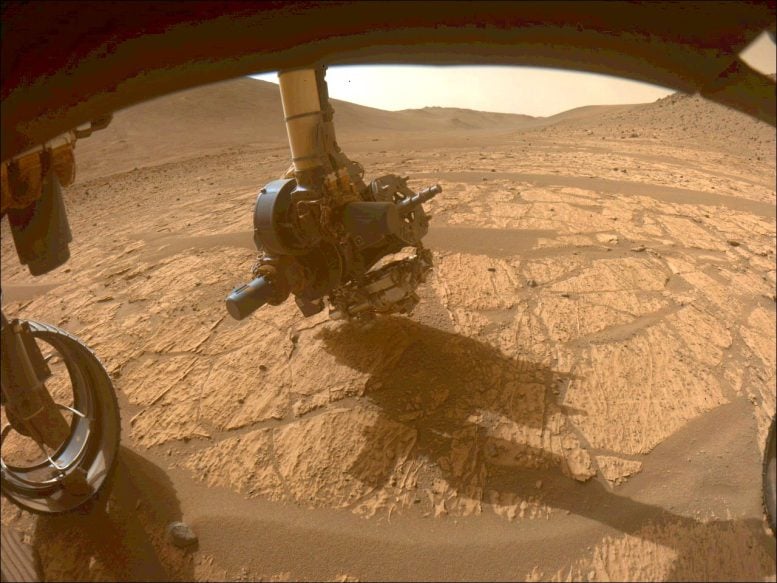
This image of NASA’s Perseverance rover collecting data on the abrasion of the Walhalla Glades was taken in the Bright Angel region of Jezero Crater by one of the rover’s forward-facing hazard-awareness cameras on June 14. The WATSON camera on the SHERLOC instrument is closest to the Martian surface. Credit: NASA/JPL-Caltech
“The Mars mission is tough, and bringing instruments back from the surface is even tougher,” said Art Thompson, Perseverance project manager at JPL. “But the team never gave up. With SHERLOC back up and running, we’re continuing our exploration and sample collection with a full suite of science instruments.”
Perseverance is in the final stages of its fourth science campaign, searching for evidence of carbonate and olivine deposits in the Margin Unit, an area along the interior rim of Jezero Crater. On Earth, carbonates typically form in shallow freshwater or alkaline lakes. It is speculated that this may also be the case for the Margin Unit, which formed more than 3 billion years ago.
Perseverance Mission Mars 2020
NASA’s Mars 2020 Perseverance mission is part of the agency’s Mars Exploration Program. Its primary goal is to search for signs of ancient life and collect samples of rock and regolith (broken rocks and soil) for eventual return to Earth.
The Perseverance rover landed on Mars on February 18, 2021, in Jezero Crater, a site believed to be the basin of an ancient river delta. The mission is also pioneering the technology needed for future human and robotic exploration of Mars. Key objectives include studying Martian climate and geology, searching for signs of ancient life, collecting Martian samples, and preparing for human exploration. In addition to its scientific instruments, Perseverance carries the Ingenuity helicopter, which demonstrates powered flight on another planet for the first time.